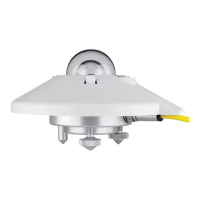.
There are no user-serviceable parts within the SMP pyranometer and it must not be opened without the agreement and instruction
of Kipp & Zonen.
8.1 Output signal not present or incorrect
The following contains a procedure for checking the instrument in case it appears that it does not function correctly:
1. Check the SMP pyranometer cable wires are properly connected to the readout equipment.
2. Check the power supply (12 VDC recommended).
3. Check that the instrument has a unique Modbus® address.
4. Compare the digital and analogue outputs to see if the problem is in one output only.
5. Check the instrument location. Are there any obstructions that cast a shadow on the instrument by blocking the direct sun
during some part of the day?
6. Check the dome, it should be clear and clean. If condensation is deposited on the inside, please change the desiccant. If too
much water is deposited internally the drying cartridge should be removed and the instrument warmed to dry it and then
replace with new desiccant. It may take several days for the sensitivity to fully recover to the original value.
7. For analogue outputs check the data logger or integrator input oset such that a signal of 0 Volt or 4 mA (as appropriate)
gives a ‘zero’ reading.
8. Check levelling. The bubble should be at least half inside the marked ring of the level.
9. If water, frost or ice is deposited on the dome, clean it. Probably water droplets will evaporate in less than one hour under
sunlight.
Any malfunction or visible damage should be reported to your Kipp & Zonen representative, who will suggest the appropriate action.
8.2 Frequently Asked Questions
The most frequently asked questions are listed below. For an update or further information refer to our website at
www.kippzonen.com
Q: Negative output during night-time measurements?
A: This error is related to Zero Oset Type A. Normally this zero oset is present when the inner dome has a dierent temperature
from the cold junctions of the sensor (the instrument housing). Practically this is always the case when there is a clear sky. Because
of the low eective sky temperature (< 0°C) the Earth’s surface emits roughly 100 W/m² of long-wave infrared radiation upwards.
The outer glass dome of a pyranometer also has this emission and is cooling down several degrees below air temperature (the
emissivity of glass for the particular wavelength region is nearly 1).
The emitted heat is attracted from the body by conduction in the domes, by wind and from the domes through infrared radiation.
The heat flow is opposite to the heat flow when absorbing solar radiation and causes the well-known zero depression at night.
This negative zero oset is also present on a clear day but is hidden in the solar radiation signal.
Zero Oset Type A can be checked by placing a light and IR reflecting cap over the pyranometer. The response to solar radiation
will decay with the response time of the instrument, but the dome temperature will go to equilibrium with a time constant of
several minutes. So after about half a minute the remaining signal is mainly Zero Oset Type A.
Good ventilation of the domes and housing minimises zero osets and increases stability. Using the Kipp & Zonen CVF4 ventilation
unit can reduce Zero Oset Type A by about 50 %.
8. Trouble shooting
.
Q: Maximum and minimum irradiation quantities?
A: Due to reflection from certain types of clouds the global irradiance at sea level can rise above the extra-terrestrial direct
irradiance (the Solar Constant) of 1367 W/m² at the top of the atmosphere (WMO 1982). Values up to 1500 W/m² have been
reported. Because the clouds move, this irradiance value mostly appears as short events of a few minutes duration.
Q: What is the primary entry point for humidity?
A: The construction of all SMP’s is waterproof, but not gastight. Therefore water vapour can slowly enter due to temperature and
pressure changes. The SMP’s without the external drying cartridge have a special sealing that makes the internal desiccant last for
10 years. The SMP11 has an external drying cartridge that is user replaceable but can also cause some leakage. It is important that
after replacing the desiccant the cartridge is clean and inserted properly (the rubber O-ring is supplied with some grease to
prevent leakage)
Q: Is the pyranometer calibration affected by the length of the signal cable?
A: With longer cable lengths the impedance increases, however it does not aect the radiometer sensitivity for the following
reason. For the SMP-V the impedance of the voltage measurement device is at least 1000 times more than the impedance of the
pyranometer plus cable. Therefore the current that goes through the readout cable is negligible and won’t generate an oset.
For the SMP-A current versions the cable length is limited by the power supply voltage and voltage drop over the cable. However the
low cable impedance (150 Ω/km) and normally high impedance of the read-out unit / logger is normally no limitation.
The digital RS-485 output can operate over cable lengths up to 1000 m, depending on the baud-rate used.
35

